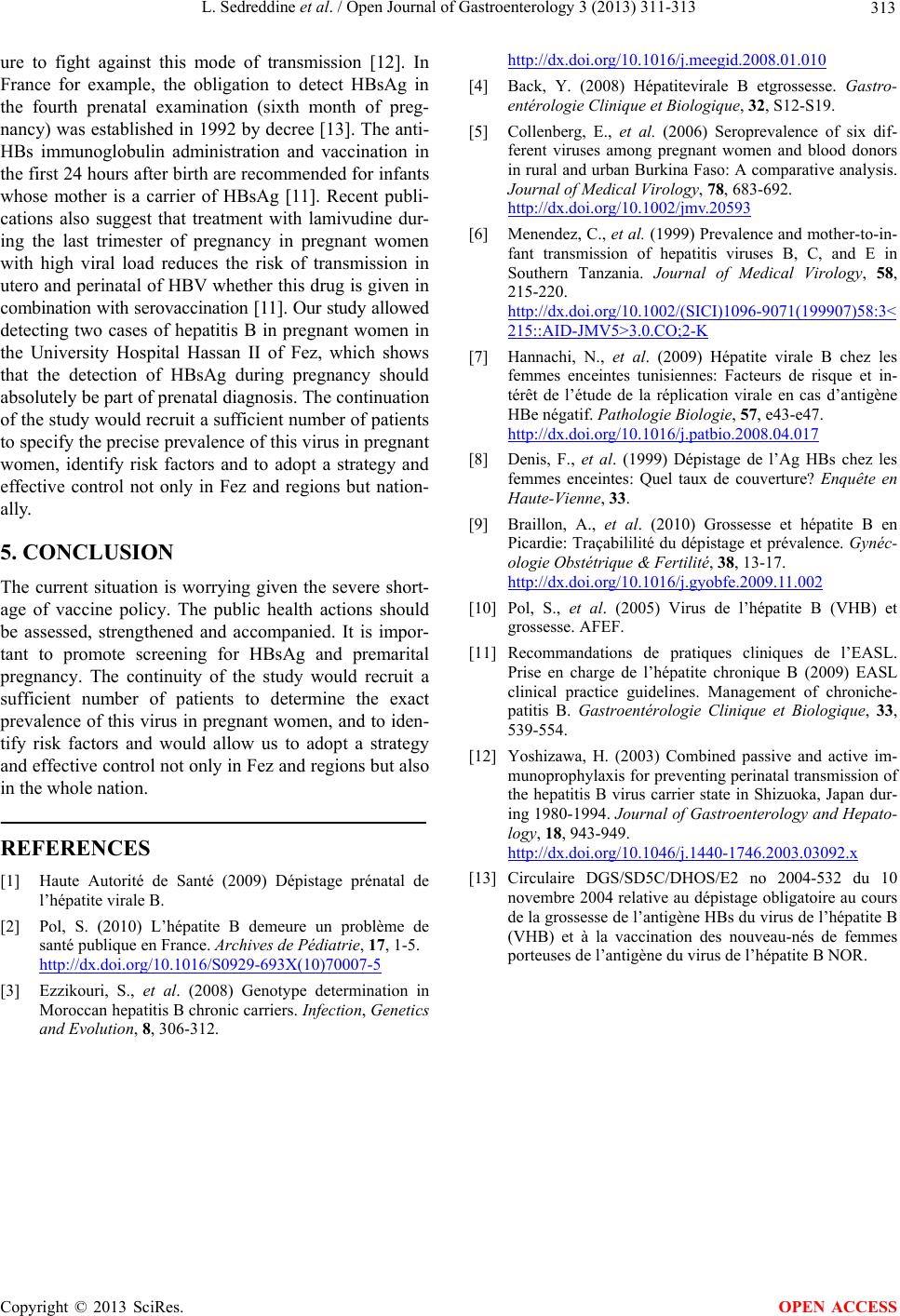
L. Sedreddine et al. / Open Journal of Gastroenterology 3 (2013) 311-313
Copyright © 2013 SciRes.
313
ure to fight against this mode of transmission [12]. In
France for example, the obligation to detect HBsAg in
the fourth prenatal examination (sixth month of preg-
nancy) was established in 1992 by decree [13]. The anti-
HBs immunoglobulin administration and vaccination in
the first 24 hours after birth are recommended for infants
whose mother is a carrier of HBsAg [11]. Recent publi-
cations also suggest that treatment with lamivudine dur-
ing the last trimester of pregnancy in pregnant women
with high viral load reduces the risk of transmission in
utero and perinatal of HBV whether this drug is given in
combination with serovaccination [11]. Our study allowed
detecting two cases of hepatitis B in pregnant women in
the University Hospital Hassan II of Fez, which shows
that the detection of HBsAg during pregnancy should
absolutely be part of prenatal diagnosis. The continuation
of the study would recruit a sufficient number of patients
to specify the precise prevalence of this virus in pregnant
women, identify risk factors and to adopt a strategy and
effective control not only in Fez and regions but nation-
ally.
OPEN ACCESS
5. CONCLUSION
The current situation is worrying given the severe short-
age of vaccine policy. The public health actions should
be assessed, strengthened and accompanied. It is impor-
tant to promote screening for HBsAg and premarital
pregnancy. The continuity of the study would recruit a
sufficient number of patients to determine the exact
prevalence of this virus in pregnant women, and to iden-
tify risk factors and would allow us to adopt a strategy
and effective control not only in Fez and regions but also
in the whole nat i on.
REFERENCES
[1] Haute Autorité de Santé (2009) Dépistage prénatal de
l’hépatite virale B.
[2] Pol, S. (2010) L’hépatite B demeure un problème de
santé publique en France. Archives de Pédiatrie, 17, 1-5.
http://dx.doi.org/10.1016/S0929-693X(10)70007-5
[3] Ezzikouri, S., et al. (2008) Genotype determination in
Moroccan hepatitis B chronic carriers. Infection, Genetics
and Evolution, 8, 306-312.
http://dx.doi.org/10.1016/j.meegid.2008.01.010
[4] Back, Y. (2008) Hépatitevirale B etgrossesse. Gastro-
entérologie Clinique et Biologique, 32, S12-S19.
[5] Collenberg, E., et al. (2006) Seroprevalence of six dif-
ferent viruses among pregnant women and blood donors
in rural and urban Burkina Faso: A comparative analysis.
Journal of Medical Virology, 78, 683-692.
http://dx.doi.org/10.1002/jmv.20593
[6] Menendez, C., et al. (1999) Prevalence and mother-to-in-
fant transmission of hepatitis viruses B, C, and E in
Southern Tanzania. Journal of Medical Virology, 58,
215-220.
http://dx.doi.org/10.1002/(SICI)1096-9071(199907)58:3<
215::AID-JMV5>3.0.CO;2-K
[7] Hannachi, N., et al. (2009) Hépatite virale B chez les
femmes enceintes tunisiennes: Facteurs de risque et in-
térêt de l’étude de la réplication virale en cas d’antigène
HBe négatif. Pathologie Biologie, 57, e43-e47.
http://dx.doi.org/10.1016/j.patbio.2008.04.017
[8] Denis, F., et al. (1999) Dépistage de l’Ag HBs chez les
femmes enceintes: Quel taux de couverture? Enquête en
Haute-Vienne, 33.
[9] Braillon, A., et al. (2010) Grossesse et hépatite B en
Picardie: Traçabililité du dépistage et prévalence. Gynéc-
ologie Obstétrique & Fertilité, 38, 13-17.
http://dx.doi.org/10.1016/j.gyobfe.2009.11.002
[10] Pol, S., et al. (2005) Virus de l’hépatite B (VHB) et
grossesse. AFEF.
[11] Recommandations de pratiques cliniques de l’EASL.
Prise en charge de l’hépatite chronique B (2009) EASL
clinical practice guidelines. Management of chroniche-
patitis B. Gastroentérologie Clinique et Biologique, 33,
539-554.
[12] Yoshizawa, H. (2003) Combined passive and active im-
munoprophylaxis for preventing perinatal transmission of
the hepatitis B virus carrier state in Shizuoka, Japan dur-
ing 1980-1994. Journal of Gastroenterology and Hepato-
logy, 18, 943-949.
http://dx.doi.org/10.1046/j.1440-1746.2003.03092.x
[13] Circulaire DGS/SD5C/DHOS/E2 no 2004-532 du 10
novembre 2004 relative au dépistage obligatoire au cours
de la grossesse de l’antigène HBs du virus de l’hépatite B
(VHB) et à la vaccination des nouveau-nés de femmes
porteuses de l’antigène du virus de l’hépatite B NOR.